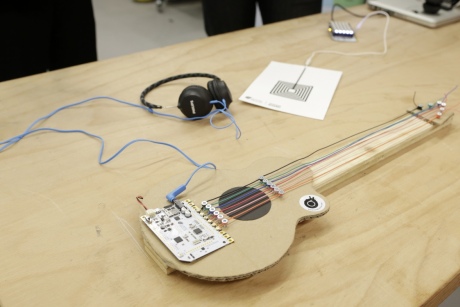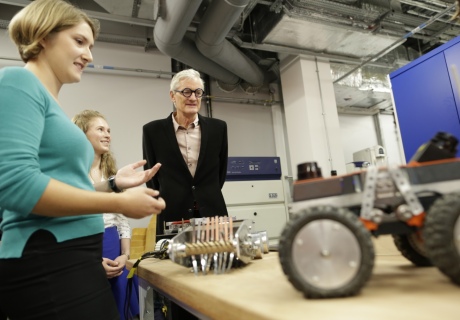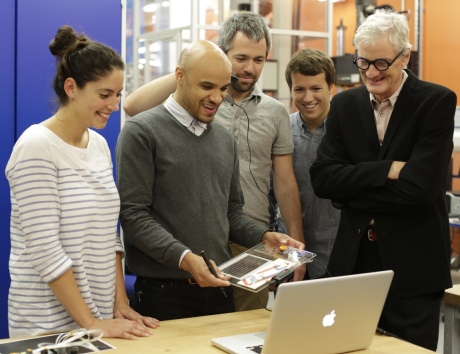Design engineering in pictures
by Colin Smith

A digital cardboard guitar and 3D air-sketching device were among Imperial inventions showcased to James Dyson.
Sir James Dyson visited Imperial in October 2014 as part of the preparations for the launch of the new Dyson School of Design Engineering at Imperial College London, announced today.
Sir James and Professor Alice Gast, President of Imperial, met with students and alumni from Imperial’s undergraduate courses and existing postgraduate design engineering courses (see side bar) who presented their devices and technologies.
Cardboard guitar

IDE alumnus Matt Johnson (right) and his colleagues have established Bare Conductive, a company that makes technology to connect any surface, object or space with the digital world. Their primary technologies consist of: an electrically conductive ink, which allows flexible electrical circuits to be painted onto anything from concrete walls to clothing; and a versatile circuit board or ‘Touch Board’, which enable these circuits to connect to sensors that are electrically conductive. Matt demonstrated the ink by painting it on to cardboard and connecting it to the Touch Board to form an electric guitar.

The guitar is constructed entirely from electrically conductive ink, a Touch Board, recycled cardboard, a piece of old wood and wires - yet the technology makes the instrument sound like a real guitar.
Monitoring kidney function

Robert Learney, a Dyson Scholar from the Department of Bioengineering, is developing technology to monitor and control kidney function in real time. In the future, this technology could be used to sustain organs outside the body for longer, which could enable more life-saving transplants to take place.
Robert demonstrated his technologies that include: a prototype pump, which could operate more effectively than existing technologies, with lower levels of damage to red blood cells that are important in kidney function; a physical sensor system, nicknamed the ‘SmartPipe’, containing sensors for pressure, temperature, flow and oxygen levels; and a chemical sensor system to continuously monitor the function of the kidney outside the body.
Robert, who used to be a doctor before switching to engineering, said: “We still need to rush the majority of organs from donor to recipient as quickly as possible. It seemed unbelievable to me that in an age where we have incubators to take care of tiny premature babies, and heart-lung machines for complicated cardiac surgery that we weren’t trying to apply these ideas to keeping single organs alive. I believe that ‘design thinking’ — seeing a problem as a whole, not only the technical and engineering aspects but also social and economic aspects — is going to make a difference to the medical world in particular. Pulling these all together under one interdisciplinary design engineering roof can only be of benefit."
Robots

Harriet Hillsin, Gemma Singer and Amanda Sjödahl, fourth year undergraduates from the Department of Mechanical Engineering, presented their robot prototypes, which they developed on one of their course modules, while working with Q-Bot Ltd on some real-world challenges the business was facing.
The robots are designed to access areas that would otherwise be too difficult or disruptive for a human operator to reach, with applications including spraying insulating foam into the floor voids under homes. Designing a robot capable of autonomously navigating narrow spaces while pulling a long hose to dispense the foam was among the challenges facing the students.
More advanced versions of these robots are now being used by Q-Bot Ltd, which is employing graduates from Imperial.
Air sketcher

Daniela Paredes Fuentes, an IDE alumna, and team members Oluwaseyi Sosanya, Guillaume Couche and Pierre Paslier explain the Gravity project to Sir James. Gravity comprises a pen and pad, and is designed for sketching digital images in 3D through the use of augmented reality glasses. The advantage of this technology is that users can sketch and alter their 3D design in real-time as if it is floating in the air, right in front of their faces.
Article text (excluding photos or graphics) © Imperial College London.
Photos and graphics subject to third party copyright used with permission or © Imperial College London.
Reporter
Colin Smith
Communications and Public Affairs